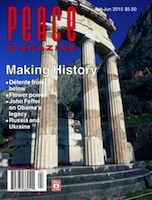
Peace Magazine Apr-Jun 2015, page 23. Some rights reserved.
Search for other articles by John Bacher here
Canadians meet a man named Issa in a Palestinian village
In November 2014 I was blessed to take part in a Basilian Peace & Justice Pilgrimage, organized by Father Bob Holmes, to the Palestinian village of Deir Istyia. Our visit was organized through the International Women’s Peace Service (IWPS), which has been present in the community to aid in resisting the Israeli government’s efforts to demolish 75 homes here.
Although it is on the West Bank, the community of Deir Istyia, a charming village of about 3,000 people, is on what the Oslo Accords term “category C” lands. This gives the Israeli government the power over land use planning and zoning, hence the ability to demolish homes which are not in conformity to their “master plans.”
The situation in Deir Istyia is politically explosive, since the community is in a valley surrounded by illegal settlements. The settlements cause havoc on the Deir Istyia residents below, through sewage discharge, traffic accidents, the uprooting of orchards, and even the release of wild pigs.
The manipulation of land use planning instruments by Israel is especially odious in Deir Istyia since the village—stone homes, with courtyards and home gardens, and streets lined with cedar, olive, carob, lemon, and orange trees—has great physical beauty. During the British mandate it had an approved official plan, which continued under Jordanian rule. It is a lush village of winding streets and ancient doorways.
In addition to organizing resistance to home demolitions, IWPS has helped Deir Istyia in many ways. It is helping, through the assistance of German investors, in developing a recycling system that will be a model for the Middle East.
The volunteers have played an important role in witnessing the violence of settlers. Speaking on condition of anonymity (since Israel routinely expels peacemakers), one volunteer described the terror of being in the community when a bout of settler violence was being unleashed. They prayed inside a shrine, while outside there was havoc, caused by exploding gasoline bombs, together with human waste and garbage, being tossed at peaceful Palestinians.
A volunteer introduced us to a key Palestinian they work with in Deir Istyia, Issa Souf. Although a Muslim, in Arabic his name means Jesus. Issa will remain in his wheelchair for the rest of his life, since he bravely went into the street-during a curfew imposed without warning, to warn children at risk of being shot to get inside. While giving out these warnings, a bullet exploded in his back. Issa explained,
“We have to realize that there are killers on both sides. On our side I would include what happens in Gaza dominated by Hamas. This is not a historical conflict. We need political solutions, but until Israel government begins to pull back by stopping new settlements we don’t have anything to talk about, although there are many issues to discuss. If they want a wall they should build it inside the pre-1967 border green line.”
Issa told us how he was injured:
“Settlers were attacking us, cutting trees and burning our villages. I went outside to tell women and children to come in. I heard gunfire. I told the soldiers I could not stand after being shot. I suffered from internal bleeding and my spinal cord was cut. The bullets used to wound me were illegal. I lost consciousness and woke up in a hospital in Nablus five days later. The bullets are still in my body and cause pain. Despite my injuries I refuse to give in to hatred. I wrote a letter to a leading Israeli newspaper Ha’aretz. It said to those who attacked us that I pity you for being a murderer. I said that I wanted to be the last victim of this conflict.”
Issa still has faith in the power of nonviolent resistance. He told us, that “Just being here is a form of resistance to the occupation. Raising families, building homes are forms of resistance. We have had a lot of success here. Although for two years there have been orders to demolish 75 homes, only two have actually been demolished.”
Issa told the pilgrims that one barrier to peace is that the foreign media will not accurately report the violence committed by extremist Israeli settlers. “I was with CNN reporters when we were about to experience a settler attack. They switched off the cameras, since they were frightened that the settlers would kill us. Despite this I have hope—if I did not I would not be here.”
John Bacher is a peace and environmental activist in St Catharines, Ontario.

Peace Magazine Apr-Jun 2015, page 23. Some rights reserved.
Search for other articles by John Bacher here